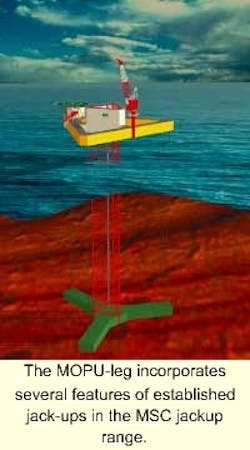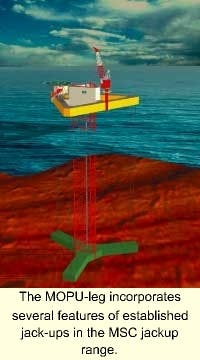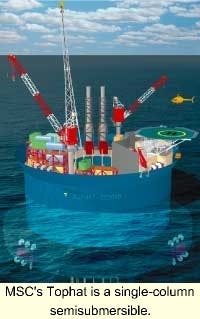Floater, jackup designed for mid-depth production operations
Two low-cost production platform conc-epts have been unveiled by Marine Structure Consultants (MSC) for mid-depth operations. The Tophat is intended for floating production and storage, while the MOPU-leg is a self-installing jackup.
Tophat is a single-column, steel semisubmersible targeted at water depths of around 300 meters. The shape (similar to a Spar) is designed to lessen motion behavior, which according to MSC (Schiedam, The Netherlands), facilitates connection and maintenance of import and export risers. It can optionally be equipped with full drilling facilities to complete, as well as drill, production wells. Storage capacity at present is 300,000 bbl, although MSC hopes to offer versions in time with 1,000,000 bbl capacity. Preliminary concept studies have been performed for the Brazilian and Australian environments.
The platform's center column is 65 meters long, while the lower body section is 86 meters long. Height to the main deck level is 33.5 meters, with an operating draft of 23.5 meters. Operating displacement is 87,000 tons. MSC estimates a construction cost for the hull alone of $110 million. The structure is designed to withstand a significant wave height of 6.1 meters at a 10.3-sec period, in addition to currents of 1.38 m/s and wind velocity of 26 m/s.
One of the key attractions of the Tophat, MSC maintains, is that it can be built in any drydock, using normal shipyard procedures for the steel construction. Outfitting can also be handled in the drydock or alternatively at the quayside. This means the unit can leave the yard fully equipped and commissioned.
Depending on the distance to the field and the availability of a transport vessel, a wet or dry tow is feasible. Once at the location, installation is achieved like any normal semisubmersible, by ballasting down to the required draft. No upending or offshore hookup is required. The 12-point pre-laid catenary mooring spread will then be connected to the Tophat and pre-tensioned.
The MOPU-leg borrows elements of previous MSC jackup designs, such as the production unit operating currently on Statoil's Siri Field in the Danish North Sea. However, that jackup had storage capability, whereas the MOPU-leg is intended purely as a wellhead platform with surface trees. It is designed for mild environment waters of 100-300 meters (three studies have been undertaken at varying depths within this range) such as Nigeria, the Gulf of Mexico, or Southeast Asia, for short or long-term production. It is designed to withstand maximum a wave height of 16 meters, 1.4 m/s surface currents, 0.4 m/s seabed currents, and wind speeds up to 44 m/s. The design incorporates the following technologies:
- Skirt-type footing as applied on MSC-modified jackup footings
- Legs as used on MSC deepwater jackups (CJ series 46, 50, and 62)
- Jacking system as deployed on all recent MSC-designed jackups
- Deck/hull/jack-house, also featuring in the MSC jackup range.
The platform is stiffened using vertical tendons pre-tensioned between the extreme corners of the hull and base. According to MSC, this effectively provides an approximate 35% topside fix to the single leg and also improves the natural period by a similar amount to around 6.6 sec.
Construction costs, excluding process equipment, are estimated at $50-125 million, depending on the size of the unit ordered. The deck can be 60-80 meters long and 60-80 meters wide, while leg length is 150-350 meters and leg width is 18-22 meters. Footing diameter is 20-25 meters, while overall weight of the structure varies from 5,000-12,500 tons.
The MOPU-leg can be assembled at a sheltered yard or at a protected deepwater site. If built at a shipyard far away from the intended location, it can be shipped over by barge or transportation vessel to the operating area. From there, it can be towed to the site using the deck's buoyancy.
On site, the unit is completely self-installing. First, the legs/substructure are lowered to the seabed, with the footings already in place. The deck is then elevated to its 16 meters air gap. Next, tendons are lowered from the deck, connected to the footings and deck and then pre-tensioned, using the jacking system. The latter is then locked to the legs, and the platform should then be ready for hook-up and subsequent production duty.


